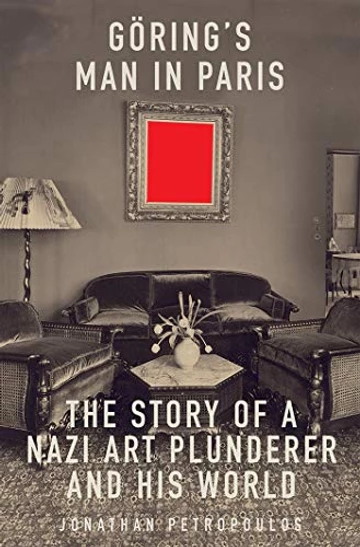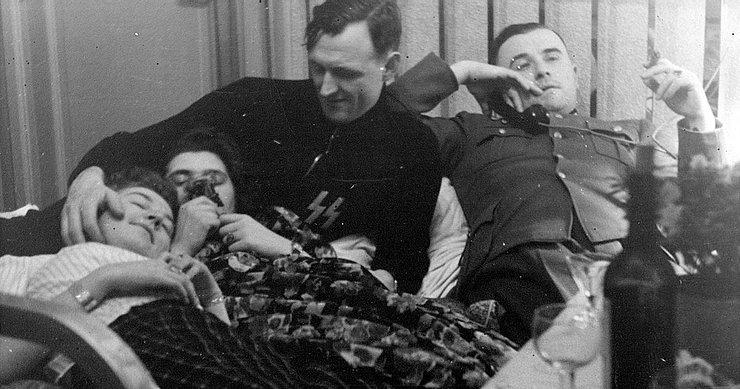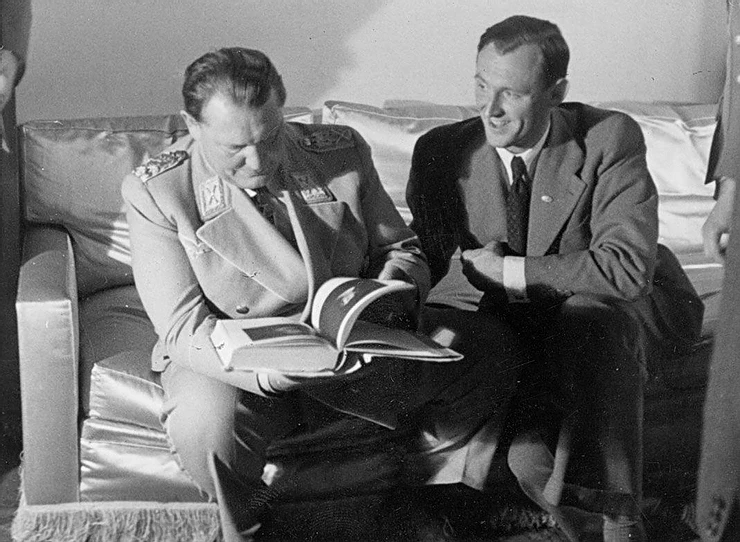News:
Professor Jonathan Petropoulos on Göring’s Man in Paris:The Story of a Nazi Art Plunderer. Interview
Caroline Cassin interviews Jonathan Petropoulos

The front cover of your new book: “Göring’s Man in Paris: The Story of a Nazi Art Plunderer and His World”( a red square in a living room) has a significance for you, can you explain to our readers?
Good question. Well, it was the book designers at Yale University Press who came up with the idea. I think the idea of the orange color is to make one think about the artwork, but not one specific artwork, but art more generally. As we know, the Nazis stole hundreds of thousands of artworks. It turns out that the photo they used was significant for me: it is the apartment of the Cassirer family in Berlin, and the picture with the orange square is the Cassirer Pissarro, which is currently in the Thyssen-Bornemisza Museum in Madrid. It is a looted picture and has never been restituted. I have worked on the restitution case for 17 years (there was a trial in Los Angeles in December 2018). The stolen work remains hanging in the Madrid museum. It is shameful for the Thyssen-Bornemisza to have this stolen artwork, and I hope the officials there feel the shame as they look at my book
I’ve heard that every Nazi leader had a massive collection of looted artworks evaluated today to millions of £, who organised the art plunder? When did it start?
I wrote about this subject in my first book (my doctoral dissertation at Harvard), where I reconstructed the art collections for about a dozen top leaders. Hitler and Goering set the example, and the other Nazi officials followed. Art collecting fit into the Nazi ideology (Aryans were bearers of culture and should appreciate art), it fit into their social aspirations to join the feudal elite (aristocrats often had great art collections), and it was part of a culture of gift-giving (art was the preferred gift). So, this behavior started right after the seizure of power as the Nazis now had the ability to collect (Hitler had bought artworks before 1933, using the royalties from Mein Kampf and Goering also started buying at that time). Once the Germans conquered much of Europe starting in 1939, they had even greater opportunity and their collections swelled in size.

Jonathan Petropoulos
Art Looting was preparing the way to kill and genocide of Jewish people, can you explain?
I wrote about this in a recent article too ("Culture Matters"--I'll attach my resume so you can find it). But in short, there were several elements linking art plundering to the Holocaust. The first was about dehumanization--taking a people's cultural property as a way to dehumanize them, to make them appear inferior. It is similar to putting people in ghettos and having them starve. The suffering people appear to conform to Nazi ideology about inferior people in the East (Jews and Slavs). The second element was profit: plundering showed the perpetrators that persecution could be profitable. Many enriched themselves and they were induced to continue to persecute people, and to take advantage of other people's suffering. So, with both dehumanization and profit, they helped lead people down "the twisted road to Auschwitz" (to quote the title of the book by Karl Schleunes).

Who is Bruno Lohse? What was his job for the Nazi?
Bruno Lohse was an art historian and a member of the SS. He was transferred to Paris in February 1941 to work in the ERR, the Nazi plundering agency based in the Jeu de Paume, and he soon became the art agent for Hermann Goering--then the second most powerful man in the Nazi regime. Lohse worked for both the ERR and Goering, and in the process, helped steal tens of thousands of artworks from Jews in France. After the war, Lohse revived his career (after he was acquitted by the Paris Military Tribunal in 1950), and he became a very wealthy man with an impressive art collection.
You met him and he left you his photographs, how was your relation, what did he say about genocide and the systematic art loot of Jewish people? Did you say that you intended to write a book about the story?
I met Lohse about 30 times between 1998 and his death in March 2007. At first, he told me about other art plunderers (he was an important source for me book Faustian Bargain), but gradually, he shared more information about himself. I think he became comfortable with me and expressed his true feelings: for example, he did not deny the Holocaust, but he did not want to talk about it (and certainly not memorialize it--he was upset by the monument in the heart of Berlin designed by Peter Eisenman). Yes, Lohse knew I was writing a book about him, but he continued to talk to me. I think he regarded it as a cat and mouse game--catch me if you can. He gave me clues about looted works, including the Fischer Pissarro, but he clearly thought he could get the better of me. He believed that the authorities would not do anything to a man in his 90s and he was overly confident that he was untouchable. Toward the end of his life, there were investigations into his wartime behaviour--including an investigation into whether he played a role in the murder of art historian August Liebmann-Meyer. So, at the very end, he became nervous. but up until that point, he was arrogant about his ability to get away with his crimes.

Hermann Goering and Bruno Lohse
Lohse sold-The Fischer Pissarro painting, can you explain the story of the artwork?
It's an entire chapter in the book (60 pages) and even then. Put simply, it was a painting stolen from the Fischer family in Vienna right after the Anschluss, and somehow, Lohse ended up with it in the 1950s. He pretended to sell it to a Swiss lawyer (Frederic Schoeni), but the lawyer actually represented Lohse (as well as the Wildensteins), and Lohse retained possession of the looted picture. I asked him about the painting for six years, and he finally decided to return it. I got to see it at the Zurich Kantonal Bank in 2007 and it eventually went back to members of the Fischer family, although not without complications.
He was not arrested and had a revival in his career, I’ve heard you talked about "culture and barbarism"…
We know that old Nazis revived their careers in the post-1950 world in many spheres--from physicians, to judges to foreign ministry officials--and the same applied to the art world. The old Nazis formed networks, and come of the works they trafficked in were looted. But they also helped museums and collectors acquire works, so there is both the culture and the barbarism.
Today, did we found most of the artworks plundered?
At the end of the war, the Allies found the various ERR repositories in Germany (the largest was in the Neuschwanstein castle), so the majority of the looted works were recovered. But Lohse traded away and sold off others, and he appeared to take some works for his own purposes. There are still thousands of works stolen by the Nazis that have never been restituted to the rightful heirs. It's part of the unfinished business of WWII. One of my friends worked for a major auction house and said that she found about 250 works that had evidence of being looted during her time at the auction house. That gives a sense of the scale (this was over a 15 year period).
What do you think of restitution today regarding Holocaust claims, do you think restitution is the best solution, why? How did the concept of restitution evolved in the last few years?
I am glad that there continue to be efforts to restitute artworks looted by the Nazis, but I wish there were not so many obstacles. The laws in Europe make civil litigation almost impossible: one relies on national committees for works in state collections (and these committees are sometime laudable in their decisions, sometimes not). So, victims and heirs rely on courts in the U.S.A. The lawyers defending the holders of looted art use technical defenses to try to block restitution (statutes of limitations, laches, the exclusion of evidence, etc.). So, it is difficult to win these cases. But we must try. We have no choice. It's the ethical thing to do. I hope that politicians pass laws that help victims and heirs: the HEAR Act was a good first step. We need more measures like that.
Can we do better to achieve a fair and just solution?
Yes, we can do better. In Europe, museums need to agree to go to the arbitration commissions to resolve claims (they sometimes refuse to let a case be heard, and that is wrong). We also need to stop letting museums and collectors use technical defenses (see above). We can do better.
Where can we find your book?
Amazon has it (so does the Yale University Press website).
2 or 3 events and or books that you will recommend to our Art Law lovers.
I like the film Woman in Gold (it's much better than Monuments Men). But let me think about the last question some more. I'll get back to you if I think of anything else. best, JP. Many thanks Professor!
Jonathan Petropoulos
William Rosenberg Senior Scholar, Yale University
John V. Croul Professor of European HistoryClaremont McKenna College
https://www.youtube.com/watch?v=Bb9DEJshxXY
PUBLICATIONS
Monographs:
“Göring’s Man in Paris: The Story of a Nazi Art Plunderer and his World” (New Haven: Yale University Press, forthcoming January 2021). Dutch and Hungarian editions forthcoming.
Artists Under Hitler: Collaboration and Survival in Nazi Germany (New Haven: Yale University Press, 2014). Czech edition, 2019; Chinese edition, forthcoming.
Royals and the Reich: The Princes von Hessen in Nazi Germany (New York/Oxford: Oxford University Press, 2006. Paperback, August 2008. United Kingdom paperback by OUP, 2009).
The Faustian Bargain: The Art World in Nazi Germany (New York: Oxford University Press, 2000). Published in the United Kingdom (London:Penguin Books, 2000. Paperback by Penguin, 2002).
Art as Politics in the Third Reich (Chapel Hill: University of North Carolina Press, 1996). Paperback edition in 1999. Translation in German (Berlin: Ullstein-Propyläen, 1999). Revised edition, 2003. Chinese edition 2013.
Some Scholarly Articles:
“Nazi Looted Art: an Oxford Bibliography” (New York: Oxford University Press, 2020).
“Brief of Amici Curiae Holocaust and Nuremberg Historians in Support of Neither Party,” in The Supreme Court of the United States, Federal Republic of Germany, et. al., v. Alan Philipp [Guelph Treasure case], (11 September 2020).
“From Tikkun Olam to Grey Zones: Reflections on a Meaningful Career,” in Ed Gaffney, ed., A Festschrift for Michael Berenbaum (Private publication, 2020).
“Culture Matters: Warning and Implications from the Holocaust,” in John Roth and Carol Rittner, eds., Advancing Holocaust Studies (New York: Routledge, 2020), 101-13.
“Art Dealer Networks in the Third Reich and in the Postwar Period,” in Jonathan Zatlin and Christoph Kreuzmüller, eds., Dispossession (Ann Arbor: University of Michigan Press, 2020), 309-31.
“Culture and Barbarism: Architecture and the Arts in Nazi Germany,” in Robert Gellately, ed., The Oxford Illustrated History of the Third Reich (Oxford: Oxford University Press, 2018), 119-56.
“Art Dealer Networks in the Third Reich and in the Postwar Period,” in the Journal of Contemporary History Vol. 52, No. 3 (July 2017) at http://journals.sagepub.com/doi/10.1177/0022009416637417 .
“Five Uncomfortable and Difficult Topics Relating to the Restitution of Nazi Looted Art,” in New German Critique 130, vol. 33, no. 1 (130) (February 2017): 125-42.
“Kunstenaars onder Hitler” in De Witte Raaf 175/30 (May-June 2015), 15-18.
“From Lucerne to Washington, DC: ‘Degenerate Art’ and the Question of Restitution,” in Olaf Peters, ed., Degenerate Art: The Attack on Modern Art in Nazi Germany, 1937 (New York: Neue Galerie, 2014), 288-307.


